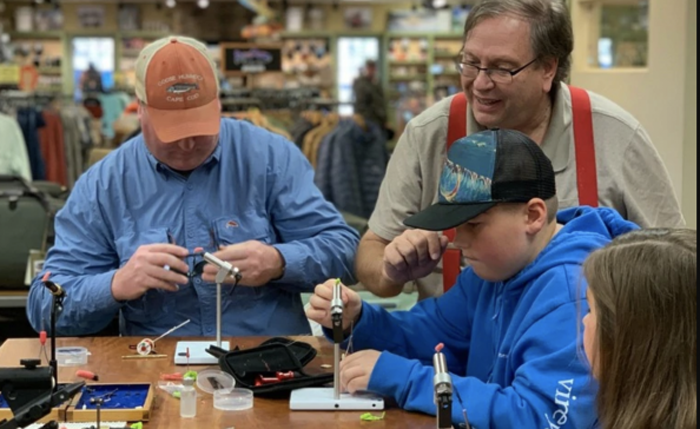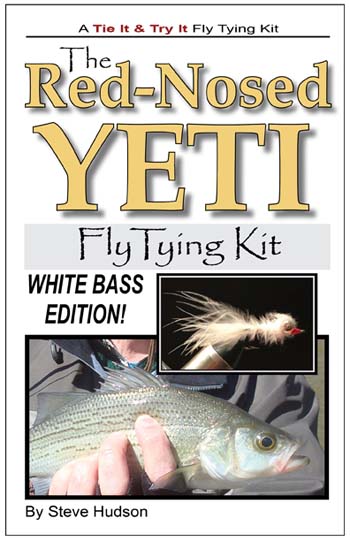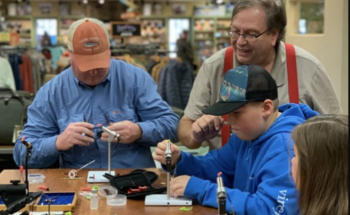
Bream Buster novitiates tying their copies of Steve Hudson fly. He looks on with care—Hudson photo.
Just one fly?
By Steve Hudson
[dropcap]T[/dropcap]he other night I presented a “fly fishing 101” program at a local fly shop. We talked about basic casting, gear, stream tactics – and flies.
It’s always fun to talk with new fly fishers about the matter of flies. Why? Perhaps because choosing which ones to use can seem like such a daunting task.

Red Nosed Yeti front cover.
Inevitably, someone asks the Big Question:
“If you could only use one fly,” asked a person in second row, “what would that fly be?”
That’s a good question, but it took me only an instant to answer.
“I’d use the Brim Buster,” I said. “The Brim Buster!”
What’s a Brim Buster? The name has been around for a long time. Among other things, it’s the name of a classic and now-legendary telescoping fiberglass fishing pole. But when I say “Brim Buster” I’m usually talking about a neat little damselfly nymph imitation that is, hands down, going to be my choice if I ever have to limit myself to just one pattern.
Damselflies resemble dragonflies, to whom they are related. While dragonflies hold their wings flat, damselflies rest with their wings held together over their body. These beneficial insects are usually found near freshwater ponds or streams. Adults lay eggs in the water, and the nymphs mature in the water before emerging (sometimes explosively) as adults. That’s when they are most available to fish.
Design strategies
Damselfly nymphs are characterized by large eyes and long, tapered bodies with three elongated gills at the tip of the creature’s abdomen. The Brim Buster suggests each of those characteristics through use of suitable materials. The eyes, for instance, are typically created from bead chain, while the body can be fashioned from either marabou or straight-cut rabbit. The key is to use a material that moves in the water.
Real damselfly nymphs have segmented bodies. Wire ribbing can be added to your imitations to create ribbing that suggests the nymph’s segmented body.
What color should that body be? Basic black or olive or brown can be hard to beat, especially when you’re directly imitating natural damselfly nymphs (which tend to be fairly dull). However, bright colors such as chartreuse can be surprisingly effective too. White works well, especially when combined with silver eyes and fished to imitate minnows near cover (for instance, where crappie might be present).
And how about size? If you can, match the length of your local damselflies; typically, that will be about 1 to 1.5 inches or a little more.
Tying the Brim Buster
The Brim Buster is easy to tie. Working on a size 10 or 12 nymph hook, start your thread about an eye diameter behind the rear of the hook eye. Then use X-wraps to tie a set of black, silver or gold bead chain eyes to the top of the hook shank about an eye diameter back from the rear of the hook’s eye.
Now move your thread to the bend of the hook and tie in the body material (marabou or rabbit strip) so that the overall length of the fly will be about an inch to an inch and a half in length. Don’t allow the body material to curve around the bend; in other words, keep it straight.
If you’re using wire for ribbing, tie in a piece of wire at this point so that it extends beyond the rear of the hook.
Next, bind the rest of the body material to the hook by wrapping thread over it and forward toward the beadchain eyes. Tie off the body material at the eyes, and trim away the excess.
If you’re including wire ribbing, the next step is to wrap your ribbing wire forward over the body in an open spiral, tying it off between the beadchain eyes.
Finally, add a few more X-wraps around the eyes to secure everything. You might even experiment with lightly dubbing your thread before making those final X-wraps.
Finish the fly by making a couple of thread wraps in front of the beadchain eyes. Then tie your favorite finishing knot, trim the thread, and apply a drop of head cement to complete the fly.
Fishing the Brim Buster
To fish the Brim Buster as a damselfly nymph, allow it to sink (try different depths) and then retrieve it in quick, short 4- to 6-inch tugs to imitate the motion of the natural. Strikes are usually unmistakable.
This fly can work well in flowing water or in still water. In ponds, during the summer, let it sink a bit to tempt deep-holding sunfish, bass, or even catfish. Yes, cats will take a fly, and in my experience this can be one that they really go after.
The Brim Buster works well in coldwater situations too. I’ve fooled many trout using this pattern, among them some wild brookies far back in the mountains of northern Georgia, North Carolina, and Virginia. Simply adjust the size until you find what the fish prefer.
Saltwater too?
There’s no doubt that Brim Busters are effective on a variety of freshwater fish. But they work in saltwater too. I’ve caught snook, speckled trout, jacks, ladyfish, and even tarpon on large all-white Brim Busters tied on size 1 or 1/0 hook. Those supersized saltwater versions are tied exactly the same their smaller freshwater cousins, though heavier molded eyes can be substituted for the lightweight beadchain to help saltwater Brim Busters get down deeper when desired.
So give the Brim Buster a try. It just might become one of your favorite flies too.
Steve Hudson writes about fly fishing, fly tying, and the outdoors. He’s the author of a number of award-winning fishing and tying guides and is the creator of the acclaimed Tie It & Try It ™ series of fly tying kits. These kits (including a Brim Buster tying kit) are available from ChattahoocheeMedia.com, from Amazon, and from many fly shops.


